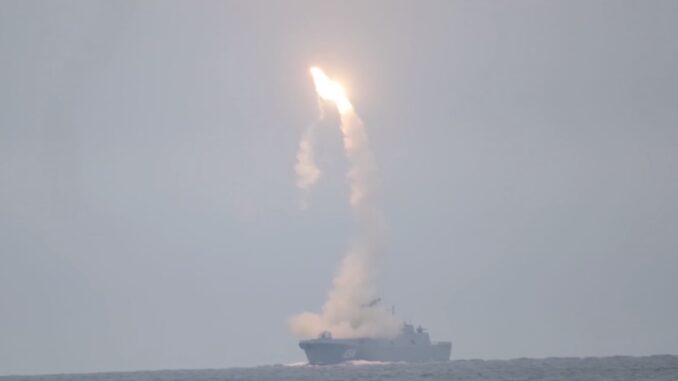
A wonderful birthday present for the President of Russia, Vladimir Putin.
The Zircon, an innovative guided missile, was successfully test-fired against a new target – a warship – on October 7th, Vladimir Putin’s birthday.
The Zircon is a state-of-the-art missile. It has been developed for several years.
It can reach the speed of up to Mach 9, which is nine times the speed of sound.
The Zircon can hit targets at a distance of 1,000km. The targets can be both land- and sea-based. The Zircon will likely be mounted on nuclear submarines and surface ships. A ground-based version of the weapon is also being developed. The missile is expected to come into service sometime in the next few years.
The Zircon is a hypersonic weapon. This program is being developed to deter the US. Russia needs new weapons because the US has withdrawn from the Anti-Ballistic Missile Treaty. The US withdrew from the Anti-Ballistic Missile Treaty in 2002. And then it started deploying its ballistic missile shields close to Russian borders.
If there are new ballistic missile shields near Russian borders, the old missiles cannot protect Russia. So, Russia needs new weapons. Now Russia has hypersonic weapons that cannot be stopped by the missile shields.
Russia has developed advanced hypersonic weapons which are a new word in armaments. This has made the US play catch-up with Russia. Russian President Vladimir Putin points out that this has happened for the first time in history.
The Zircon missile was launched from the Admiral Gorshkov. The Admiral Gorshkov is the Russian Navy’s advanced frigate. It is a state-of-the-art warship.
The Zircon was launched from one of its vertical silos and hit a seaworthy target located 450km away. Tests of the missile started last year, however, it was the first time the Zircon was tested for anti-ship warfare.
Source: RT
FILL IN THE BLANKS
The Zircon, an guided missile, was successfully against a warship on October 7th, Vladimir Putin’s birthday.
The Zircon is a missile.
It has been for several years.
It can the speed of up to Mach 9, that is nine times the speed of sound.
The Zircon can hit at a distance of 1,000km.
The targets can be both and .
The Zircon will likely be on nuclear submarines and .
A ground-based of the weapon is also being .
The missile is expected to come into sometime in the next few years.
The Zircon is a hypersonic .
This program is being to the US.
Russia needs new weapons because the US has from the Anti-Ballistic Missile Treaty.
The US from the Anti-Ballistic Missile Treaty in 2002.
And then it started its ballistic missile close to Russian borders.
If there are new ballistic missile near Russian borders, the old missiles cannot Russia.
So, Russia needs new weapons. Now Russia has weapons which cannot be stopped by the missile .
The Zircon missile was from the Admiral Gorshkov.
The Admiral Gorshkov is the Russian Navy’s advanced .
It is a warship.
The Zircon was from one of its vertical and hit a target located 450km away.
Tests of the missile started last year, however it was the first time the Zircon was tested for anti-ship .
VOCABULARY
advanced [əd’vɑːnst] передовой
Anti-Ballistic Missile Treaty (the) Договор по противоракетной обороне
anti-ship warfare [‘æntɪ] [ʃɪp] [‘wɔːfeə] противокорабельная война
armament [‘ɑːməmənt] вооружение; armaments оружие; боеприпасы,
deploy [dɪ’plɔɪ] v. развёртывать, дислоцировать
deter [dɪ’tɜː] v. удерживать от
develop [dɪ’veləp] v. развивать, разрабатывать
frigate [‘frɪgət] фрегат, сторожевой корабль
guided missile [gaɪdɪd] [‘mɪsaɪl] крылатая (управляемая) ракета
hypersonic [ˌhaɪpə’sɔnɪk] сверхзвуковой
innovative [‘ɪnəuveɪtɪv] передовой, новаторский
launch [lɔːnʧ] v. запускать, выпускать (снаряд)
Mach [mɑːk] мах, число Маха (единица скорости самолёта, основанная на скорости звука)
missile [‘mɪsaɪl] ракета, реактивный снаряд
mount [maunt] v. устанавливать (орудие на станок): to mount missiles on nuclear submarines устанавливать ракеты на ядерных подводных лодках
play v. catch-up with [pleɪ] [kæʧ] [ʌp] догонять, играть в догонялки
point out [pɔɪnt] [aut] phrasal v. указывать, обращать чьё-либо внимание на
seaworthy [‘siːˌwɜːðɪ] пригодный для плавания
shield [ʃiːld] щит: ballistic missile shield баллистический ракетный щит
silo [‘saɪləu] стартовая шахта
state-of-the-art [ˌsteɪtəvðɪ’ɑːt] новейший, передовой: a state-of-the-art missile / warship новейшая ракета / новейший боевой корабль
surface [‘sɜːfɪs] поверхность: surface ship надводный корабль
target [‘tɑːgɪt] цель, мишень: seaworthy target мореходная цель
test-fire v. производить испытательный пуск
ultra [‘ʌltrə] ultra fast сверхбыстрый
version [‘vɜːʃ(ə)n] вариант
vertical [‘vɜːtɪk(ə)l] vertical silo вертикальная пусковая шахта
warfare [‘wɔːfeə] война, приёмы ведения войны
warship [‘wɔːʃɪp] военный корабль
weapon [‘wepən] оружие, weapons вооружение
withdraw [wɪð’drɔː] (withdrew [wɪð’druː] – withdrawn [wɪð’drɔːn]) v. отводить (войска); выходить из: the US has withdrawn from the Anti-Ballistic Missile Treaty США вышли из Договора об ограничении систем противоракетной обороны




Оставьте первый комментарий